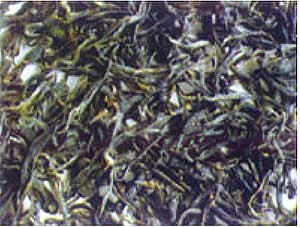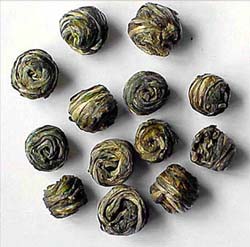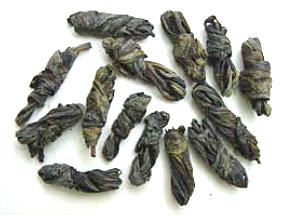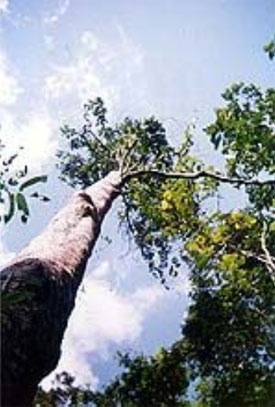
KU DING CHA
Ku Ding Cha is a beverage tea consumed in China as an alternative to the more common, ordinary green tea. The standard Chinese tea, from Camellia sinensis, is known as cha, and this term is then applied to other herbs that are consumed in similar manner. Ku Ding describes this particular beverage tea: ku means bitter, which aptly describes the initial taste, and ding is a Chinese character that looks like a spike (middle character, below), depicting the appearance of the dried, long leaves when they are twisted into a narrow nail-like piece; they can also be formed into balls or rolls (photos next page). The herb name is often written as a single transliterated word-kudingcha-and is sometimes misspelled without the g, as kudincha.

Ku Ding Cha was described in the Bencao Gangmu Shiyi (1765), originally called Dong Qing, which refers to the fact that it is an evergreen tree (dong means winter, or written another way, frozen, and qing means green; it is the tree that stays green through the winter). This term, being rather general, led to some confusion about source materials, two groups of plants were being utilized for the tea: the holly (species of Ilex) and the wax tree (species of Ligustrum). Today, it is estimated that more than 90% of the Ku Ding Cha used in China is from an Ilex, mainly Ilex kudingcha (though other Ilex species, such as Ilex latifolia, may be used), while several species of Ligustrum are substituted in Sichuan Province and in Japan. Both the holly and wax tree are evergreens, their leaves have a somewhat similar appearance, and the wax insect that feeds off the wax tree is also found occasionally on the holly. The leaves of Ilex kudingcha (young plant pictured here) are long, slim, without the points common to other holly plants, and somewhat rubbery in texture.

Considerable health benefit is attributed to Ku Ding Cha. In traditional Chinese medicine terms, it is used to disperse wind-heat, clear the head and the eyes, and resolve toxin, thus being used for common cold, rhinitis, itching eyes, red eyes, and headache. In addition, it is said to calm fidgets and alleviate thirst, especially when one is suffering from a disease that causes fever or severe diarrhea. It transforms phlegm and alleviates coughing, thus used in treating bronchitis. Finally, it is said to invigorate digestion and improve mental focus and memory.
Modern research suggests that the herb, whether derived from Ilex or Ligustrum, promotes blood circulation, lowers blood pressure, and lowers blood lipids, including cholesterol. It has the reputation of preventing deterioration of the heart and brain function and maintaining proper body weight. The main active components appear to be triterpene glycosides (saponins), which have been dubbed kudinosides and kudinlactones; it also contains polyphenols and flavonoids, somewhat like those found in ordinary tea.
 
|

|
 
|
| Photos: leaf shapes of Ku Ding Cha (upper left); collected leaves before twisting and roasting (upper right); Ku Ding Cha in spike form (center picture); ball form (lower left), and roll form (lower right) |
One of the main growing locations for Ilex is in Guangxi Province of southwestern China (see map, last page); in particular, in Daxin County. The oldest Ilex tree is found growing there: it is about 30 meters high (100 feet), and has grown for centuries (see photo next page). In that county, there are about 3,400 acres (more than 5 square miles) of Ilex kudingcha trees under cultivation. Ilex is also grown throughout southern and central China and Vietnam.
The experience of drinking the tea is somewhat unusual. The taste of the tea is a pure, distinctive bitter, which, at first, would seem to make it undesirable. But, there is also an underlying sweet taste, one which becomes pronounced once the bitter wears off, a moment after taking a sip of the tea. It doesn't take too long to become accustomed to the taste and then find it attractive, in much the same way that coffee and other bitter drinks are desired. The strength of the tea can be adjusted to one's liking. It takes only a few spikes, typically 3-5 of them, to make a pot of tea for one person; hot water can be added again to the leaves, even several times, to make more tea.


The oldest and largest Ku Ding Cha tree in China, located in Daxin, Guangxi
In 1997 an Institute was established to research and develop Ku Ding Cha and other local Guangxi remedies. It is the Nanning Guangbo Institute for Developing Effective Folk Medicinal Prescriptions. Nanning is the main city of the Daxin region in Guangxi. A product has been developed that combines Ku Ding Cha with momordica, chrysanthemum, gardenia, imperata, morus leaf, and other herbs, and is used for clearing heat. It is recommended for counteracting overheating during the summer, for treating sore throat, alleviating the effects of consuming alcohol or smoking cigarettes, and resolving other hot-type conditions.
Another popular combination is ginkgo leaf (Yin Xing Ye) with Ku Ding Cha (the combination called Yin Xing Ku Ding Cha). This emphasizes the circulation promoting and memory enhancing effects of both herbs. For example, a tea of this mixture is produced under the Xinquan brand, manufactured by Guizhou Haoli Industry, in Guiyang City, Guizhou.
A company in Zhejiang Province, the Sierkang Kudingcha Tea Company, deals almost exclusively in Ku Ding Cha (Danquan Brand). The company has established tea manufacturing, seedling cultivation bases, and 38 processing spots; it has set up product distribution shops in Shanghai, Beijing, and other cities.
The proliferation of Ku Ding Cha production, research, manufacturing, and formulation assures that this valuable leaf will eventually gain world-wide recognition as a health promoting beverage and ingredient in prepared herbal medicines.
 Map showing Guangxi, a major growing region for Ku Ding Cha. This herb is also grown in all the surrounding areas shown: Guizhou and Hunan to the north, Guangdong to the east, Yunnan and Vietnam to the West. It is also grown on Hainan Island, in the South China Sea. |
The information for this article was culled from several sources, including a variety of internet postings and Chinese language illustrated Materia Medica books. The main reference texts were:
December 2002